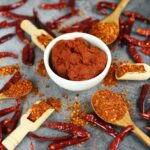Herbs and spices contribute a lot of flavor to food.
For this reason, all cuisines around the world tend to use herbs and spices to enhance the taste properties of various dishes.
Even though they are generally used in small quantities, they can also offer a good source of nutrients and polyphenols too.
This article lists 50 different types of herbs and spices to try.
1) Allspice
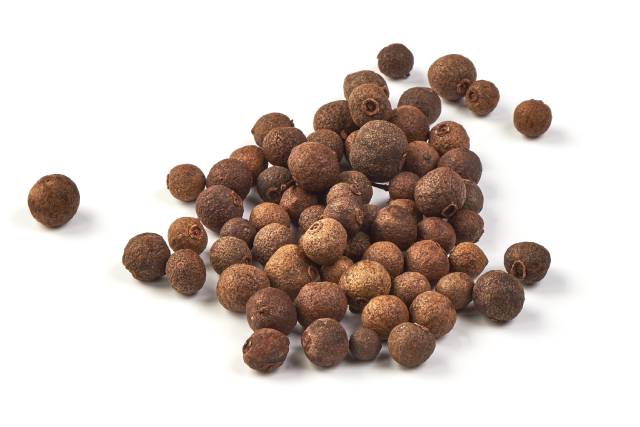
- Botanical name: Pimenta dioica
- Other names: Jamaica berry, myrtle pepper, pimenta, pimento,
- Flavor: fragrant, warming, strong
- Associated cuisine: Caribbean, Mexican, Middle Eastern
- Uses: curries, general seasoning, stews
- Used in: Jerk chicken
- Available form: dried ground powder, whole dried berries
Allspice usually comes in the form of ground, dried, powder which is derived from a dried berry from the Pimenta dioica tree (1).
English people in the early 1600s gave allspice its name due to the fact that it tastes similar to several other spices such as cloves and nutmeg (2).
This spice is popular around the world, and it is commonly used in seasoning/curry mixes and for adding depth of flavor to soups and stews. It can also be used to give a sweet and spicy taste to desserts.
2) Annatto
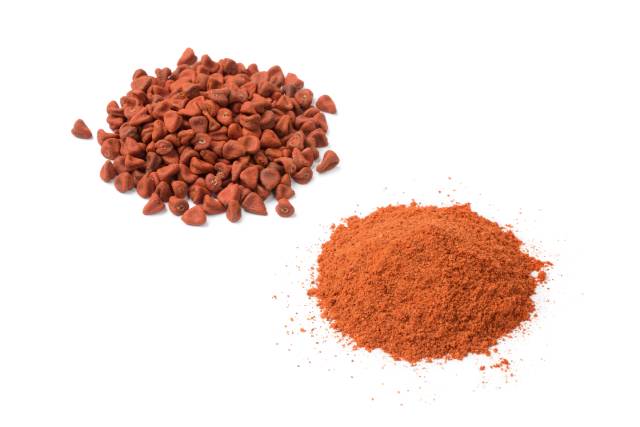
- Botanical name: Bixa orellana
- Other names: Achiote, arnotta, latkan, rocou,
- Flavor: peppery, spicy,
- Associated cuisine: Caribbean, Mexican, South American
- Used in: Hallacas
- Uses: food coloring, general seasoning, marinades
- Available form: dried ground powder, paste, whole dried berries,
Annatto has a peppery and somewhat spicy taste, and it is mainly used as a general seasoning in cooked dishes.
Among these uses, annatto features in the Venezuelan dish hallacas, and it is a key ingredient in recado rojo, a Mexican spicy paste.
However, annatto is also a popular food coloring, and it gives food an orange-to-red shade of color. Annatto has been used as a food coloring in cheese since the 17th century (3).
3) Anise
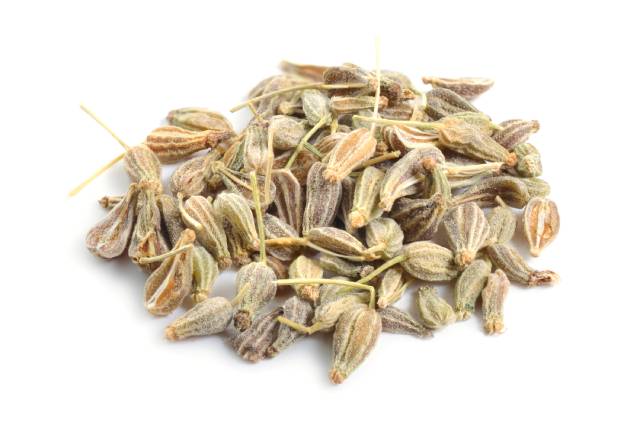
- Botanical name: Pimpinella anisum
- Other names: Anis, Aniseed, Pinella, Sweet cumin
- Flavor: Mildly sweet, peppery, spicy
- Associated cuisine: Mediterranean
- Used in: Aniseed balls
- Uses: confectionary and sweets, liquor
- Available form: ground powder, seeds
Anise seed is typically used alongside sugar in confectionary to provide a sweet and somewhat spicy flavor.
One of the most famous products using anise seed is aniseed balls. These little balls are small, hard, and shiny with a sugar-coated exterior and strong anise flavoring throughout.
There is also a wide range of anise-based liquors, such as raki, a popular Turkish drink.
4) Basil (Sweet)
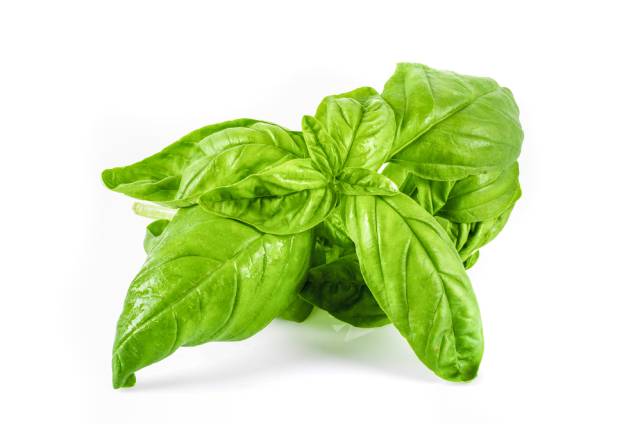
- Botanical name: Ocimum basilicum
- Other names: Common basil
- Flavor: Mildly sweet, minty, spicy
- Associated cuisine: Chinese, Italian, Thai
- Used in: Pesto
- Uses: General seasoning, sauces, spice blends
- Available form: whole leaves, ground leaves
There are many different varieties of basil, but the sweet basil cultivars are the most common.
Basil is the key ingredient in basil pesto, a delicious herby-tasting condiment from Italy.
It is also used for flavoring in various dishes, including Chinese-style stir-fries such as Thai basil chicken.
5) Bay Leaf
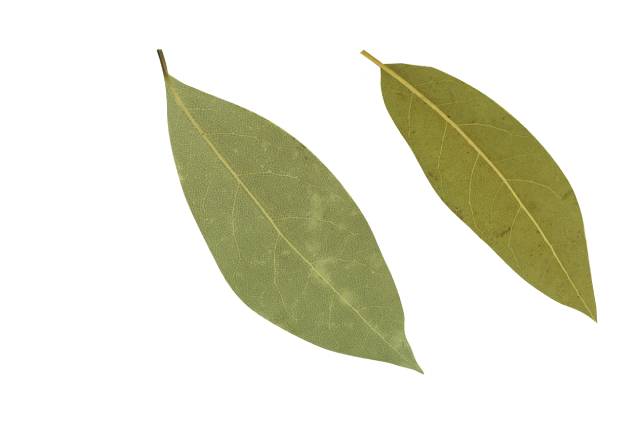
- Botanical name: Laurus nobilis
- Other names: Bay Laurel
- Flavor: Bitter, minty, peppery
- Associated cuisine: Caribbean, French, South Asian, Filipino
- Used in: Biryani, adobo
- Uses: Curries, general seasoning, spice blends,
- Available form: whole leaves, dried ground leaf
Bay leaves are popular around the world for their flavor-enhancing properties.
These leaves are also very easy to use, and whole leaves can be added to a dish during cooking (and either removed or left) to add depth of flavor.
Bay leaves feature in a range of popular foods around the world, such as biryani and adobo.
6) Caraway
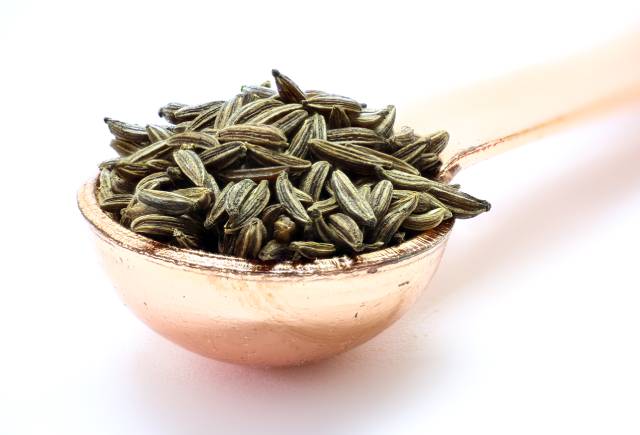
- Botanical name: Carum carvi
- Other names: wild cumin
- Flavor: Earthy, nutty, licorice-like,
- Associated cuisine: European, Middle Eastern,
- Used in: Sauerkraut, harissa
- Uses: Curries, general seasoning, spice blends,
- Available form: ground powder, whole seeds
Caraway seeds have a nutty and licorice-like taste. Either whole caraway seeds or ground caraway can be used, and both help enhance the flavor of food.
Some popular foods that use caraway seeds include condiments such as harissa paste and sauerkraut.
However, caraway also works well in a wide range of curries, soups, and stews. The taste is flavorful but not overpowering, so it can work well in most dishes.
7) Cardamom
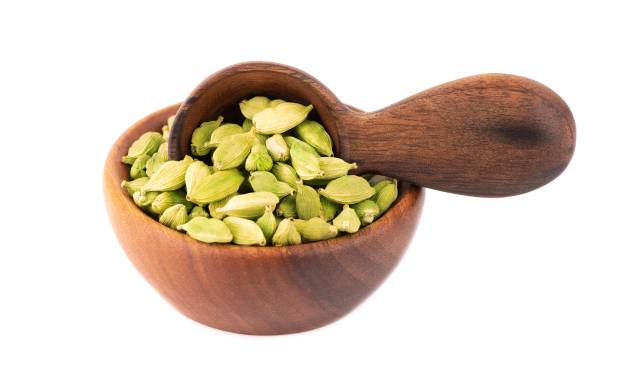
- Botanical name: Elettaria cardamomum
- Other names: Cardamon, cardamum, green cardamom
- Flavor: Citrusy, peppery, slightly sweet
- Associated cuisine: South Asian, Middle Eastern
- Used in: Masala chai, Turkish coffee
- Uses: Bread, confectionary, curries, drinks, general seasoning, spice blends,
- Available form: ground powder, whole seeds
True cardamom is also known as ‘black cardamom,’ and it is a versatile spice that features in a range of cooked dishes, drinks, and sweets.
It is prevalent in Indian cuisine and features in a wide range of Indian dishes.
One downside is that cardamom is one of the most expensive types of spice due to the labor-intensive methods used to produce it (4).
8) Cayenne Pepper
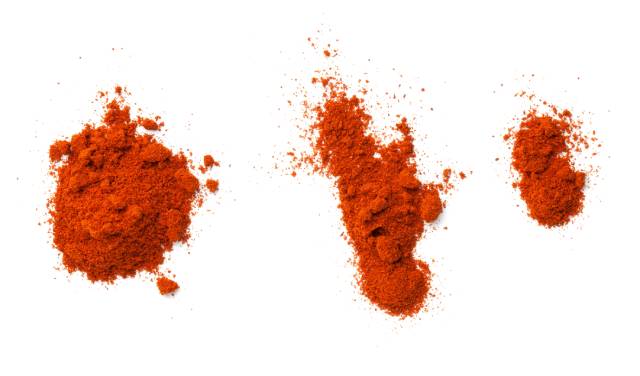
- Botanical name: Capsicum annuum
- Other names: Chili pepper
- Flavor: Hot, peppery, spicy
- Associated cuisine: South Asian, Mexican
- Used in: Curries, fajitas, enchilada
- Uses: Curries, general seasoning, marinades, sauces, spice blends,
- Available form: fresh peppers, ground powder
Cayenne pepper belongs to the Capsicum annuum species of plants alongside bell peppers and jalapenos.
Also, cayenne pepper tends to be extremely spicy, widely featuring in a range of spicy Indian and Mexican foods. This hot taste comes from a chemical compound that cayenne peppers contain called capsicum (5).
Aside from typical dishes, cayenne can also be added to a wide variety of cooked foods as a flavor enhancer.
See this full guide to cayenne pepper’s nutritional profile and potential benefits
9) Celery spice
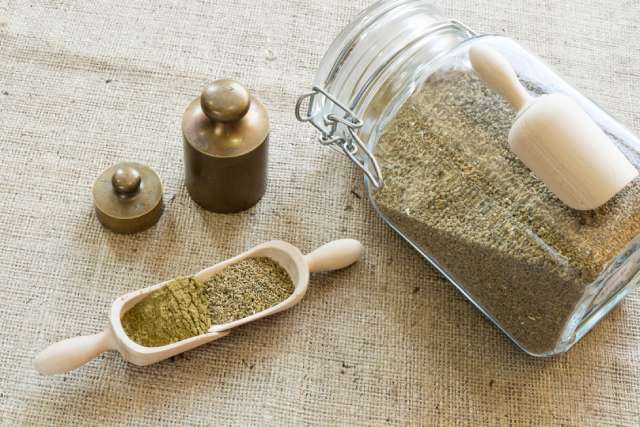
- Botanical name: Apium graveolens
- Other names: Celery seed, garden celery, wild celery
- Flavor: Bitter, earthy
- Associated cuisine: Various
- Uses: Cooked dishes, general seasoning, sauces, soups, stews
- Available form: seeds, ground powder, celery salt
Despite the name, celery spice is unrelated to the regular celery people use in their salads.
Celery spice comes from the seeds of wild celery, and these seeds have an earthy and slightly bitter flavor.
The spice is used in a wide variety of cuisines as a flavor-enhancing addition to a dish.
It is also available to buy as ‘celery salt,’ which is a product that is approximately two-thirds salt and one-third ground celery seed.
Celery salt can be sprinkled onto a wide variety of foods in the same way as regular salt.
10) Chili Pepper
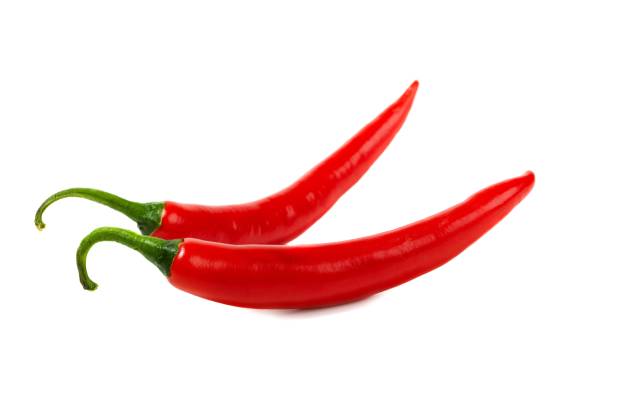
- Botanical name: Capsicum annuum
- Other names: Chili pepper
- Flavor: Hot, peppery, spicy
- Associated cuisine: South Asian, Mexican
- Used in: Curries, fajitas, enchilada
- Uses: Curries, general seasoning, marinades, sauces, spice blends,
- Available form: fresh peppers, ground powder
Chili powder generally shares the same characteristics as cayenne pepper.
The only real difference is that cayenne pepper should be hotter because it contains more cayenne.
Regarding chili powder, this spice generally contains a variety of ground chili peppers, including (but not exclusively) cayenne peppers.
11) Chives
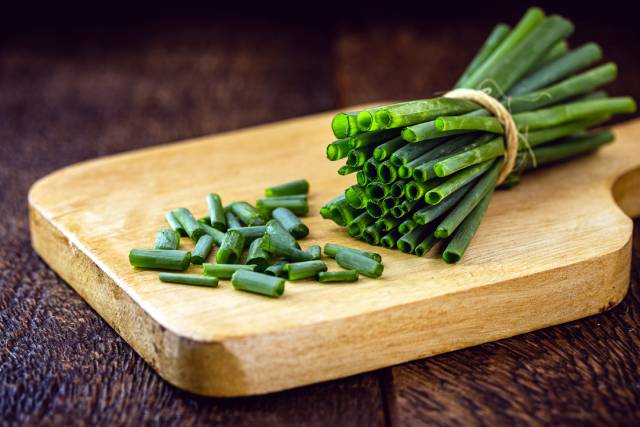
- Botanical name: Allium schoenoprasum
- Other names: Chive
- Flavor: Sweet, onion and garlic-like,
- Associated cuisine: European
- Used in: Dairy products, potato chips/crisps
- Uses: Flavoring cooked dishes, soups, stews,
- Available form: fresh chives, ground chive flakes
Chives are one of the most common herb varieties, and they’re a member of the allium family alongside garlic, leeks, onions, and shallots.
They have a mildly sweet and enjoyable flavor and have a taste that somewhat resembles onion and garlic.
Adding some chives to a dish can provide a big flavor boost.
12) Cilantro
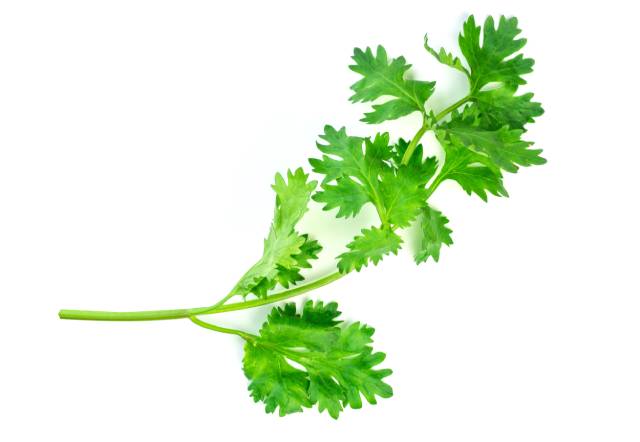
- Botanical name: Coriandrum sativum
- Other names: Chinese parsley, coriander
- Flavor: Citrusy, earthy, nutty
- Associated cuisine: Chinese, South Asian
- Used in: Garam masala
- Uses: Curries, general seasoning, spice blends
- Available form: Dried leaves, fresh leaves, ground seeds, whole seeds
Cilantro is a love or hate type of spice, with some people perceiving it to have a ‘soapy’ taste (6).
However, it remains one of the world’s most popular spices, and it plays a large role in Chinese and Indian cuisine.
The leaves of the plant are typically referred to as cilantro and used as a herb. On the other hand, the seeds (and ground powder) are known as coriander.
13) Cinnamon
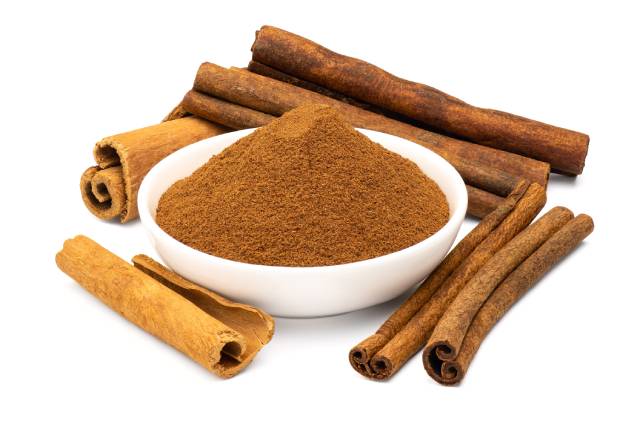
- Botanical name: Cinnamon verum
- Other names: Cinnamon bark, cinnamon stick, ceylon cinnamon, cassia cinnamon
- Flavor: Earthy, fruity, slightly sweet, warming
- Associated cuisine: Chinese, Indian, Mexican, Middle Eastern
- Used in: Mulled wine, pumpkin pie
- Uses: Baking products, cereals, hot drinks, spice blends, sweet desserts
- Available form: Cinnamon sticks, ground powder
There are several cinnamon varieties, but Cinnamomum verum is sometimes known as ‘true cinnamon’ (7).
Since the spice has slightly sweet properties, it tends to be used in sweet dishes.
Cinnamon powder has a fine yellowy-brown appearance, and it is commonly added to hot chocolate. Also, cinnamon sticks are often an ingredient in seasonal drinks like mulled wine.
14) Cloves
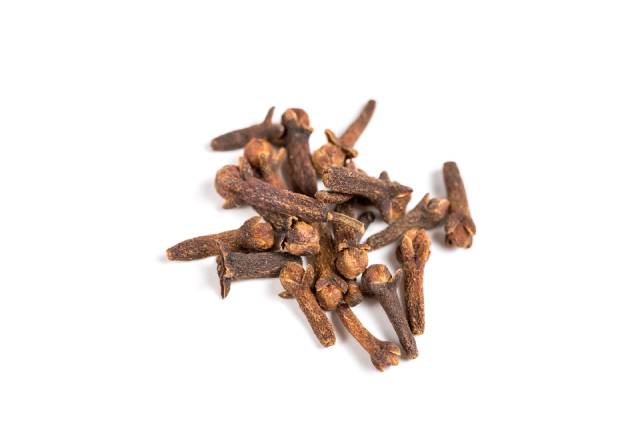
- Botanical name: Syzygium aromaticum
- Flavor: Bitter, earthy, slightly sweet, warming
- Associated cuisine: Asian, African, Middle Eastern
- Used in: Pho, Pumpkin pie
- Uses: curries, marinades, sauces, spice blends, sweet desserts
- Available form: Dried flower buds, ground powder
Cloves share some resemblance to cinnamon, but they have a slightly more bitter flavor.
This spice is very flavorful and often feature in curries, marinades, and sauces across numerous cuisines.
15) Cumin
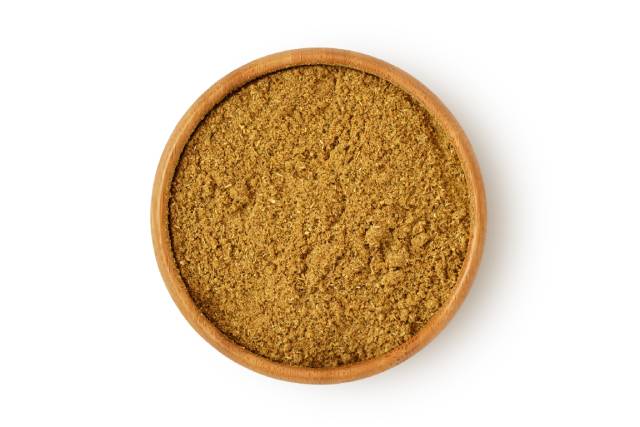
- Botanical name: Cuminum cyminum
- Other names: Black cumin seed, cummin
- Flavor: Bitter, earthy, nutty, warming, peppery
- Associated cuisine: South Asian
- Used in: Jeera aloo
- Uses: Curries, general seasoning, soups, stews, spice blends
- Available form: Ground powder, whole seeds
Cumin seeds are very flavorful and offer an earthy, warming taste. For this reason, they work very well in curries and hot soups and stews.
However, using a little bit too much can bring out strong bitter notes; using cumin sparingly is the key.
16) Dill
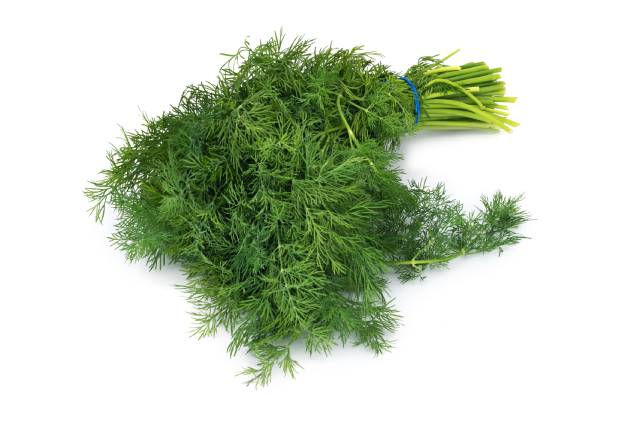
- Botanical name: Anethum graveolens
- Other names: Aneth, Dill herb, Dillweed,
- Flavor: Citrusy, earthy, slightly peppery
- Associated cuisine: Asian, European, Middle Eastern
- Used in: Cucumber dill salad
- Uses: Curries, salads, soups, stews
- Available form: Fresh/dried leaves, ground powder
People use dill as both a herb and a spice; the fresh green leaves are used as a herb in cooking, and the ground dried seeds are a popular spice.
The herb has a mild lemon-like citrusy taste, and it is slightly spicy/peppery, but not as much as some other spices.
17) Fennel
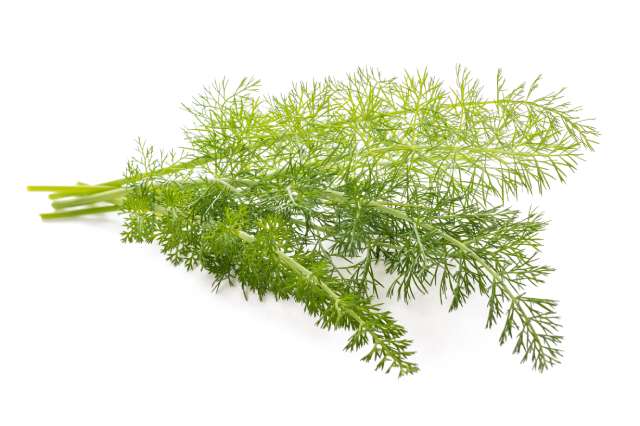
- Botanical name: Foeniculum vulgare
- Other names: Finocchio, Garden fennel, sweet fennel, wild fennel
- Flavor: Anise-like, mildly sweet, peppery
- Associated cuisine: Chinese, Mediterranean, Middle Eastern, South Asian
- Used in: Chinese five-spice powder
- Uses: Curries, general seasoning, spice blends
- Available form: Fresh/dried leaves, ground powder
Fennel belongs to the carrot family of plants, and its leaves are used as a herb and its seeds as a spice.
Fennel is very popular around the world and features in everything from Chinese and Persian cooking to European salads.
Perhaps the most famous fennel use is the five-spice seasoning blend that enjoys popularity in China (and around the world).
18) Fenugreek
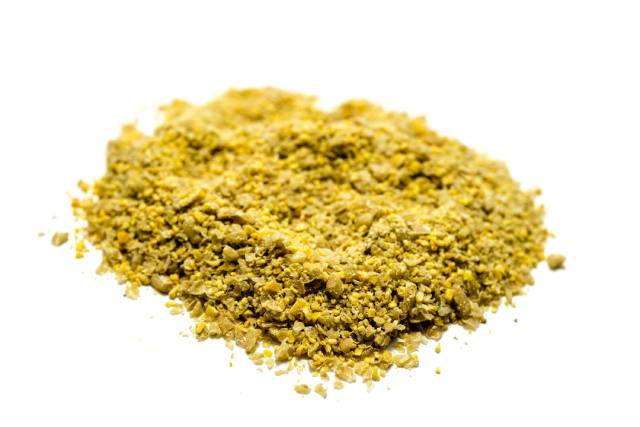
- Botanical name: Trigonella foenum-graecum
- Other names: Chandrika, Greek hay, Greek hay seed, methi, trigonelle
- Flavor: Bitter, mildly sweet, nutty
- Associated cuisine: Middle Eastern, South Asian
- Used in: Methi gobi
- Uses: Curries, drinks, general seasoning, marinades,
- Available form: Fresh/dried leaves, ground powder
Fenugreek is a powerful tasting herb (in leaf form) and spice (ground seeds).
It is the key ingredient in methi gobi, a popular Indian side dish that combines fenugreek (methi) and cauliflower (gobi).
19) Galangal (greater)
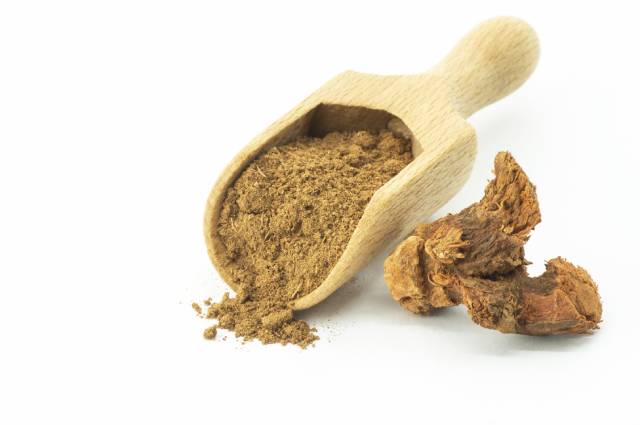
- Botanical name: Alpinia galanga
- Other names: Alpinia, blue ginger, Chinese ginger, galangal, galangal root, lengkuas
- Flavor: Ginger-like, peppery, warming
- Associated cuisine: Chinese, Southeast Asian
- Used in: Rendang
- Uses: Curries, soups, stews
- Available form: Fresh/dried roots, ground powder
Greater galangal is the most common culinary type of galangal.
Galangal is a spice made from the dried roots of the Alpinia galanga plant. The spice has hot and warming characteristics similar to ginger.
It is most popular in Chinese and Southeast Asian cuisine, and it is one of the key ingredients in the Indonesian dish rendang.
20) Garam Masala
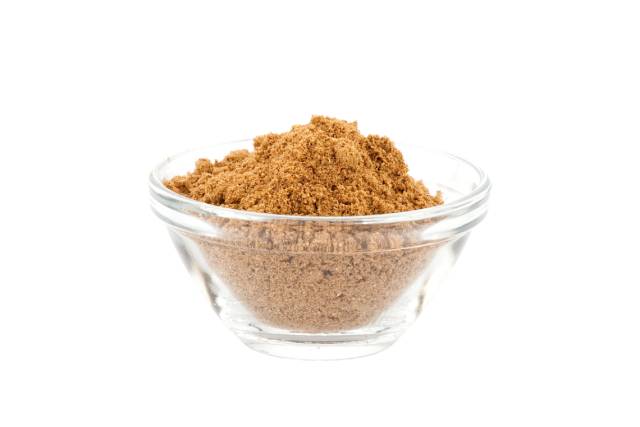
- Botanical name: N/A
- Other names: N/A
- Flavor: Mildly sweet, peppery, spicy, warming
- Associated cuisine: South Asian
- Used in: Numerous curries
- Uses: Curries, general seasoning
- Available form: Ground powder
Garam masala is not a single spice; instead, it is a mixture of popular spices.
The name ‘garam’ means heat, and ‘masala’ means a mix of spices.
While the exact mixture of spices may vary, a traditional garam masala typically contains cloves, cinnamon, cumin, coriander, and red chili powder.
21) Garlic
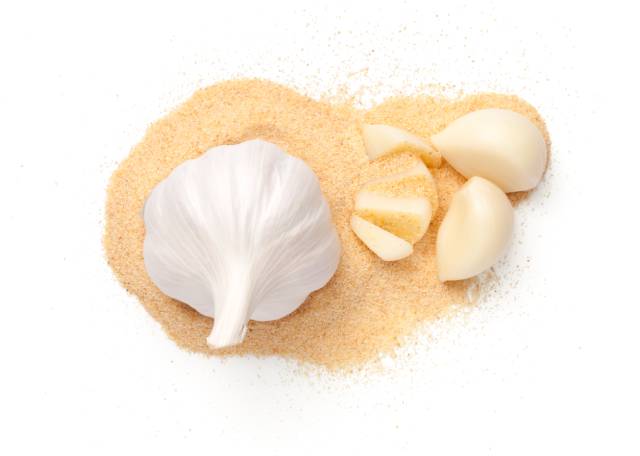
- Botanical name: Allium sativum
- Flavor: Bitter, slightly sweet, spicy, pungent
- Associated cuisine: Numerous
- Used in: Aioli, garlic bread, hummus
- Uses: Bread, curries, general seasoning, pasta, soups, stews
- Available form: Fresh garlic bulbs, garlic powder, mashed garlic
Garlic is the bulb of a flowering plant called Allium sativum. Botanically, garlic is a vegetable, but people generally use it as a herb or spice.
Garlic is one of the most commonly used herbs and spices, and it features heavily in cuisines around the world.
22) Ginger
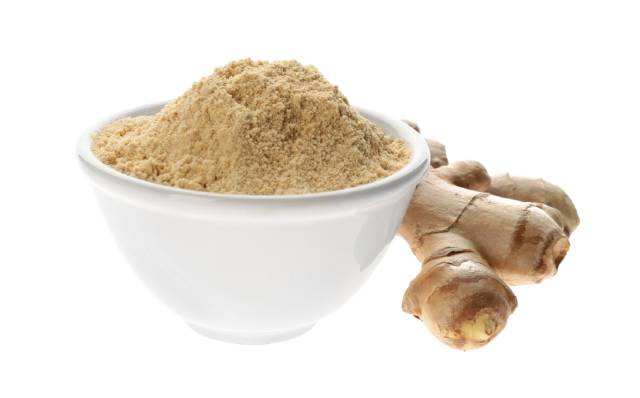
- Botanical name: Zingiber officinale
- Flavor: Earthy, spicy, warming
- Associated cuisine: Numerous
- Used in: Gingerbread men, kimchi
- Uses: Baked goods, Curries, drinks, general seasoning, sweet foods
- Available form: fresh/dried root, ground powder
Ginger is the root of a flowering plant called Zingiber officinale, and it is one of the most common culinary spices.
Ginger has a warming, flavorful, and slightly spicy taste, and it works well in a range of savory and sweet dishes.
The spice appears in everything from gingerbread men and sweet drinks in Europe to kimchi and curries in Asia.
23) Grains of Paradise
- Botanical name: Afromomum melegueta
- Other names: African pepper, melegueta pepper
- Flavor: Citrusy, peppery, spicy, warming
- Associated cuisine: North and West African
- Uses: Drinks, general seasoning, soups, stews, sweet foods
- Available form: Dried seeds, ground powder
Despite not being very common in much of the Western world, grains of paradise has long been a popular spice in Africa.
Grains of paradise can be used as a like-for-like replacement for black pepper, which is where the name ‘African’ pepper originally came from.
24) Horseradish
- Botanical name: Armoracia rusticana
- Other names: Mountain radish, raifort
- Flavor: Earthy, mildly sweet, peppery, spicy
- Associated cuisine: European, North American
- Used in: Horseradish sauce
- Uses: Pickles, sauces, as a condiment
- Available form: Fresh/dried root, ground horseradish, sauce
The roots of the horseradish plant are used as a culinary spice in cuisines around the world.
Horseradish has a hot and pungent taste, and it is commonly used as a condiment (horseradish sauce).
25) Jalapeño
- Botanical name: Capsicum anuum
- Other names: Chile gordo, huachinango, jalapa
- Flavor: Earthy, mildly sweet, peppery, spicy
- Associated cuisine: Mexican
- Used in: Jalapeno poppers
- Uses: Mexican foods, salsa, toppings
- Available form: Fresh, pickled, dried ground powder
Jalapeño is another type of chili pepper, and it is from the Capsicum anuum family of plants.
Jalapeños are used as a spice either in their fresh, preserved, or dried form.
Since they are not quite as hot as other types of chili pepper, jalapeños can be enjoyed by people who prefer a milder spicy than options like cayenne pepper.
26) Juniper berry
- Botanical name: Juniperus communis
- Other names: Enebro
- Flavor: Citrusy, earthy, peppery
- Associated cuisine: Northern European
- Used in: Gin
- Uses: Drinks, general seasoning
- Available form: Dried berries, ground spice powder
Despite their name, juniper berries are not true berries, but they do have a similar appearance.
People use juniper berries in their dried form as a spice to flavor different foods.
Gin is perhaps the most famous product juniper berries are used in, and the spice gives gin its characteristic taste.
27) Marjoram
- Botanical name: Origanum majorana
- Other names: Garden marjoram, majoran, marwa, pot marjoram
- Flavor: Citrusy, mildly bitter, piney, slightly sweet, warming
- Associated cuisine: Mediterranean
- Used in: Pizza sauce
- Uses: general seasoning, sauces, soups, stews
- Available form: Dried/fresh leaves
Marjoram is a variety of herb that is available in either fresh or dried form, and it belongs to the mint family of plants.
This herb’s taste is very flavorful and contributes a range of different flavors when added to sauces and cooked dishes.
28) Mustard seed
- Botanical name: Brassica alba, Brassica juncea Brassica nigra,
- Other names: Black mustard, brown mustard, yellow mustard, white mustard seed, Sinapis alba
- Flavor: Hot, mildly sweet, peppery, spicy
- Associated cuisine: Numerous
- Used in: Mustard (condiment), paturi
- Uses: general seasoning, marinades, pickling, sauces
- Available form: Dried seeds
Mustard seeds come in three main colors: yellow, brown, and black. The yellow seeds tend to be quite mild, with the brown and black seeds being somewhat spicier.
Adding mustard seeds to various dishes – whether ground or whole – can add a lot of flavor to the food.
These seeds are also used to make commercial mustard condiments, which vary in their spiciness depending on the amount (and type) of mustard seed used.
29) Nigella
- Botanical name: Nigella sativa
- Other names: Black cumin, black onion seed
- Flavor: Bitter, onion-like, peppery, pungent
- Associated cuisine: South Asian, Middle Eastern, North African, Polish
- Used in: Aloo checkhi
- Uses: Bread, curries, general seasoning, sauces, soups, stews
- Available form: Dried seeds, ground powder
Nigella seeds are apparently one of the oldest types of spice used by humans, and they were found in the tomb of the ancient Egyptian king Tutankhamun.
Sprinkling these seeds into sauces, soups, and stews can give a big burst of flavor.
30) Nutmeg
- Botanical name: Myristica fragrans
- Other names: Muscade, muscadier, myristica
- Flavor: Earthy, nutty, slightly sweet, warming
- Associated cuisine: European, Indian, Indonesian
- Used in: Rice pudding, mulled wine
- Uses: Baked goods, general seasoning, marinades, sweet dishes,
- Available form: Dried seeds, ground powder
Nutmeg is a popular spice in many countries for its distinct and aromatic flavor.
A sprinkle of nutmeg can enhance the flavor of various cooked dishes, desserts, and hot drinks such as coffee and hot chocolate.
Generally speaking, nutmeg is used as a spice for savory dishes in Asian cuisine and sweet foods and drinks in European cuisine.
31) Oregano
- Botanical name: Origanum vulgare
- Other names: Mountain mint, origanum, wild marjoram,
- Flavor: Bitter, earthy, pungent, warming
- Associated cuisine: Italian
- Used in: Pizza
- Uses: General seasoning
- Available form: Dried/fresh leaves, ground leaves
Oregano is a herb that shares some characteristics with marjoram, which is a related herb.
However, oregano has a much stronger flavor, and it can be overpowering when using too much.
Oregano is a staple herb used in Italian cooking, and it features in a wide range of Italian dishes, including pizza.
32) Panch Phoron
- Botanical name: N/A
- Other names: N/A
- Flavor: Bitter, earthy, nutty, peppery
- Associated cuisine: Indian
- Uses: General seasoning, marinades, soups, stews
- Available form: Ground power
Panch phoron is an Indian ‘five-spice’ blend that features black mustard seed, cumin, fennel, fenugreek, and nigella seed.
This spice is versatile and can be used to sprinkle on top of grilled fish and meat or cooked dishes.
Just a small amount can help to enhance the flavor of soups and stews.
33) Paprika
- Botanical name: Capsicum anuum
- Flavor: Mildly sweet, sometimes smoky
- Associated cuisine: Numerous
- Used in: Goulash
- Uses: General seasoning, marinades, soups, stews
- Available form: Dried ground powder
Paprika is a large chili pepper, but it doesn’t have the same heat as other varieties.
For this reason, people tend to use paprika for a mildly sweet and sometimes smoky taste rather than for spiciness.
The smoky taste is apparent in ‘smoked paprika,’ which smoke-dries paprika chilies before grinding them down into a powder.
Paprika is used in various dishes among cuisines worldwide, with the national dish of Hungary—goulash—being a notable one.
34) Parsley
- Botanical name: Petroselinum crispum
- Other names: Common parsley, Garden parsley, parsley root
- Flavor: Mildly bitter, peppery
- Associated cuisine: Numerous
- Used in: Salsa Verde
- Uses: General seasoning, marinades, sauces
- Available form: Dried/fresh leaves, ground leaves
Parsley enjoys widespread use in the kitchen around the world.
This popular herb features in a range of condiments, soups, and stocks, and it is one of the main ingredients in the Italian condiment salsa verde,
Parsley also features in numerous European and Middle Eastern cooked dishes.
35) Pepper
- Botanical name: Piper nigrum
- Other names: Black pepper, white pepper, green pepper
- Flavor: Hot, peppery, pungent, spicy
- Associated cuisine: Worldwide
- Uses: General seasoning
- Available form: dried peppercorns, ground black pepper
Black pepper is the world’s number one spice, accounting for approximately 20% of the world spice trade.
It has a hot, sharp, and peppery taste and combines well with most foods.
36) Perilla
- Botanical name: Perilla frutescens
- Other names: Black pepper, white pepper, green pepper
- Flavor: Aromatic, cooling, minty, nutty
- Associated cuisine: Korean, Japanese
- Used in: Korean BBQ
- Uses: General seasoning, wrapping meat, soups, stews
- Available form: ground powder, leaves, seeds
Perilla leaves are used as herbs/vegetables, and the ground perilla seeds are used as a spice.
Perilla belongs to the mint family, and it has a cooling and minty taste. If you go to a Korean barbecue, it is common to see meat being wrapped in perilla leaves.
As for ground perilla seed, this flavorful spice works well for flavoring soups and stews.
37) Poppy seed
- Botanical name: Papaver somniferum
- Flavor: Earthy, nutty
- Associated cuisine: European, Indian
- Used in: beigli
- Uses: Bread, cakes, thickening sauces, pastries
- Available form: whole dried seeds
Poppy seeds are often used to add some flavor to bread, cakes, and pastries.
They are the main ingredient in beigli, which is a rolled cake filled with poppy seeds.
Poppy seeds also feature in various Indian dishes as a spice and thickener.
38) Quassia
- Botanical name: Quassia amara
- Other names: Amargo, bitter wood, ruda
- Flavor: Bitter
- Associated cuisine: Globally used food additive
- Used in: Drinks
- Uses: Flavoring beer, drinks, and baked goods
- Available form: wood chips, ground powder
Quassia comes from the bark of a small tree known as Quassia Tamara.
While not really popular as a commonly used herb at home, it is an additive used in various food industry products.
Quassia can be bought in bark chips or ground powder form.
39) Rosemary
- Botanical name: Salvia rosmarinus
- Other names: Anthos, old man, romero, rusmari, rusmary
- Flavor: Earthy, citrusy, minty, peppery
- Associated cuisine: Mediterranean
- Used in: Rosemary tea
- Uses: Drinks, flavoring foods
- Available form: Fresh/dried leaves, ground powder
Rosemary is a member of the mint family, and it has a distinctive herbal taste. It is also very versatile and enjoys widespread use as a variety of tea, culinary herb, and more.
As a flavoring aid, rosemary is often placed on meat during cooking. Since rosemary has a bold flavor, only a small amount is necessary to affect the overall taste.
40) Saffron
- Botanical name: Crocus sativas
- Other names: Indian saffron, kashmira, kesar, Spanish saffron,
- Flavor: Earthy, grassy, slightly sweet, pungent
- Associated cuisine: European, Middle-Eastern, South Asian
- Used in: Golden Ham, paella
- Uses: Drinks, flavoring meats and grains, dry-curing,
- Available form: Ground powder, saffron threads
Saffron is the most expensive spice in the world today, and for a good reason. Apparently, 75,000 saffron flowers are required to make just one pound (454 grams) of saffron.
One of the most famous saffron uses is in the Spanish dish paella; saffron both flavors and colors the rice.
41) Sage
- Botanical name: Salvia officinalis
- Other names: Common sage, garden sage, meadow sage, true sage
- Flavor: Citrusy, earthy, nutty, peppery, piney,
- Associated cuisine: American, British,
- Used in: Stuffing
- Uses: Flavoring cheese and meats, herbal tea, stuffing
- Available form: Dried leaves, ground powder
Sage is a popular herb in Britain and the United States, and it is commonly used as an ingredient in stuffing, which is served alongside roast meats.
Sage is also a popular seasoning added to various products such as cheese and sausages.
42) Sesame
- Botanical name: Sesamum indicum
- Other names: Beniseed, sesamo,
- Flavor: Earthy, mildly sweet, nutty,
- Associated cuisine: Numerous cuisines globally
- Used in: Bread buns, hummus, tahini
- Uses: Adding flavor to food, used in cooked dishes
- Available form: Ground powder, whole seeds
Sesame seeds are widely used as a spice for the mildly sweet and nutty depth of flavor they add to food.
These tasty seeds are often used as a topping on bread buns or sprinkled into a cooked dish for added flavor.
Sesame is especially popular in East Asian cuisines, and a variety of Japanese and Korean dishes include sesame seeds.
43) Sichuan pepper
- Botanical name: Zanthoxylum piperitum
- Other names: Dried prickly ash
- Flavor: Citrusy, fruity, piney
- Associated cuisine: Chinese
- Used in: Mapo tofu
- Uses: General flavoring, soups, stews, stir-fries
- Available form: Dried peppercorns, ground powder
Despite having ‘pepper’ in the name, Sichuan pepper has no relation to other pepper varieties.
The taste is also very different, with Sichuan pepper offering a fresh and fruity flavor.
Interestingly, eating Sichuan pepper results in a tingling sensation on the lips and tongue. This is temporary and nothing to worry about; a chemical compound in the spice causes it (8).
44) Star Anise
- Botanical name: Illicium verum
- Other names: Chinese anise, Chinese star anise, Eight-horned anise, Staranise, star aniseed
- Flavor: Sweet, licorice-like
- Associated cuisine: Chinese, Southeast Asian
- Used in: Biryani, masala chai
- Uses: Curries, drinks, general seasoning,
- Available form: Ground powder, whole seeds
Despite the similar name, star anise is a totally different spice (and plant) to regular anise.
Star anise contains an oil called anethole which gives it a licorice-like flavorful taste (9).
As a flavorful spice, star anise is one of the five flavors in Chinese ‘five spice.’
45) Stevia leaf
- Botanical name: Stevia rebaudiana
- Other names: Stevia
- Flavor: Earthy, sweet
- Associated cuisine: Worldwide
- Used in: Stevia sweetener
- Uses: Sweetening drinks and dishes
- Available form: Dried/fresh leaves
Most people think of stevia as a sugar-alternative rather than a type of herb.
However, the whole leaf form of stevia can be used in various dishes as a sweetening agent.
The leaves may also be processed into a sweetener.
46) Tarragon
- Botanical name: Artemis dracunculus
- Other names: Estragon
- Flavor: Bitter, licorice-like, peppery, pungent,
- Associated cuisine: French
- Used in: Béarnaise sauce
- Uses: Drinks, general seasoning, soups, stews
- Available form: Fresh/dried leaves, ground leaves
Tarragon is a boldly flavored herb that is particularly famous in French cuisine.
This herb is one of the key ingredients in Béarnaise sauce, a tasty condiment that combines shallots, tarragon, butter, egg yolks, and white wine vinegar.
For other uses, tarragon works particularly well in creamy sauces, soups, and stews and adds a big flavor boost.
47) Thyme
- Botanical name: Thymus vulgaris
- Other names: Common thyme, garden thyme, thym
- Flavor: Citrusy, earthy, minty, peppery
- Associated cuisine: Jamaican
- Used in: Jamaican rice and peas
- Uses: General seasoning, marinades, soups, stews
- Available form: Fresh/dried leaves, ground leaves
Thyme is a popular herb in the United States and numerous European countries, but it is perhaps most popular in Jamaica.
In Jamaica, most common dishes contain thyme, which gives off a flavorful citrusy, minty, and peppery taste.
48) Turmeric
- Botanical name: Curcuma longa
- Other names: Curcuma, Indian saffron,
- Flavor: Bitter, earthy, peppery, pungent, warming
- Associated cuisine: Asian (especially Indian)
- Uses: Curries, Food coloring, general seasoning, soups, stews
- Available form: Fresh, dried ground powder
Turmeric is a popular spice that is prevalent in Asian cuisine, but particularly so in India.
This spice has a strong yellowy-orange color and changes the color of food in much the same way as saffron. Perhaps for this reason, it has an alternate name of ‘Indian saffron.’
Turmeric is most commonly used in curries, and it provides an earthy, pungent, and warming taste.
49) Vanilla
- Botanical name: Vanilla planifolia
- Other names: Vanilla bean, vanilla extract
- Flavor: Creamy, sweet, warming
- Associated cuisine: Popular worldwide
- Used in: Vanilla extract
- Uses: Flavoring drinks, ice-cream, sweet baked goods
- Available form: Ground powder, paste, vanilla extract, whole beans
Vanilla is one of the tastiest, mildest, and most expensive types of spice.
After saffron, vanilla is the second most expensive spice globally, mainly due to the work required to find and produce it.
However, this spice is also delicious and just a small amount gives a delicious flavor to foods and drinks.
50) Wasabi
- Botanical name: Wasabia japonica
- Other names: Japanese horseradish
- Flavor: Hot, pungent, spicy
- Associated cuisine: Japanese
- Used in: Sushi
- Uses: General flavoring, condiment with raw fish,
- Available form: Fresh root, paste
Wasabi a popular Japanese condiment used as a spice with a unique green color.
It is most famous for its use in sushi; a small amount is typically found between the raw fish and the rice.
While historically popular mainly in Japan, wasabi’s popularity has grown alongside the growing worldwide interest in sushi.
Wasabi has a hot and pungent flavor and only tiny amounts are necessary.
What Is the Difference Between Herbs and Spices?
Herbs and spices are similar in utility, and we use both to give our food a bit of extra flavor.
Thus, it isn’t uncommon for people to feel confused about the difference between the two.
The explanation is relatively simple; herbs tend to be the green leaves of a plant. For example, we think of chives, oregano, and rosemary as herbs.
In contrast, spices tend to come from the bark, seeds, and roots of a plant, and we can usually find these spices in dried and powdered form. For instance, we think of cinnamon, nutmeg, and turmeric as spices.
Among the two, herbs tend to have a milder, more delicate flavor, whereas spices have a bolder and more powerful flavor when the amounts are equal.
Final Thoughts
Overall, adding a few herbs and spices to our culinary repertoire can really offer something new and exciting in the flavor department.
That said, most of these herbs and spices are extremely flavorful, and it is easy to overdo them, so tread carefully!

